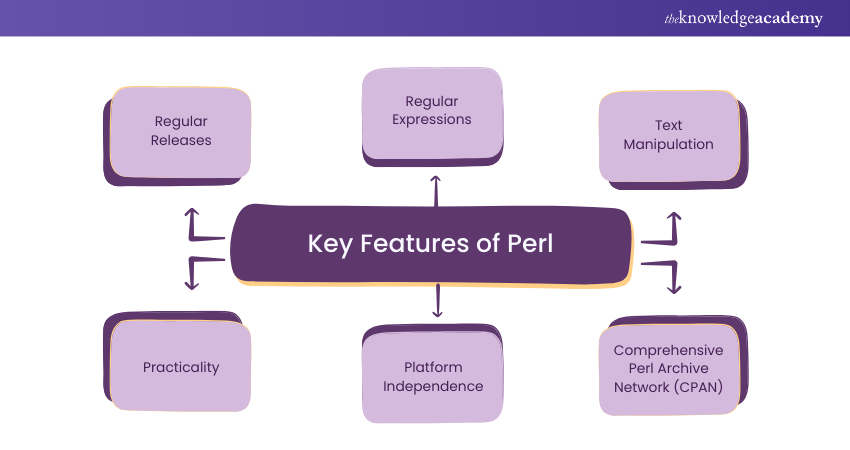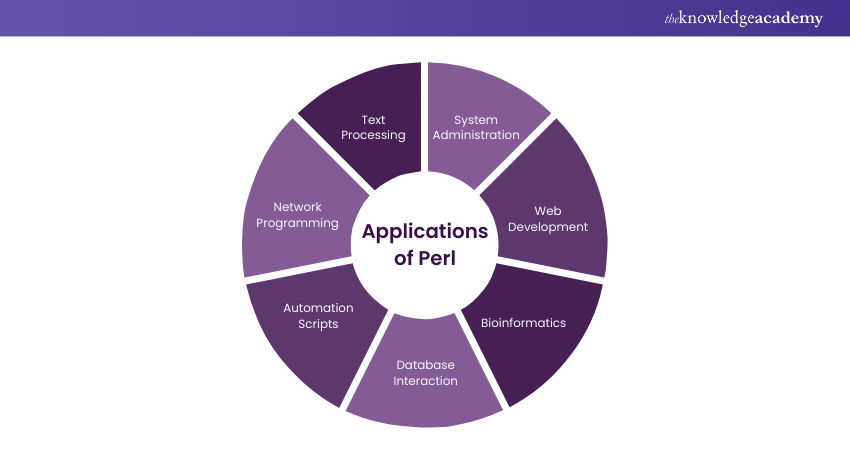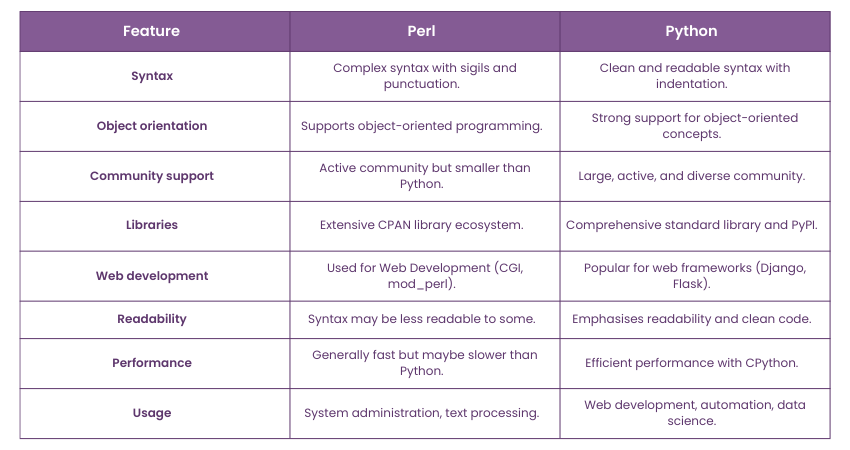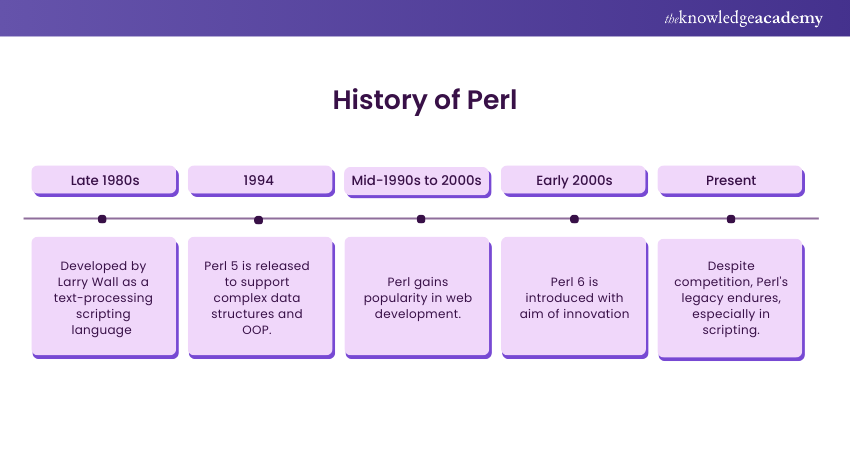We may not have the course you’re looking for. If you enquire or give us a call on +60 1800812339 and speak to our training experts, we may still be able to help with your training requirements.
Training Outcomes Within Your Budget!
We ensure quality, budget-alignment, and timely delivery by our expert instructors.

In a tech landscape flavoured by numerous Programming Languages, Perl still stands as a powerful chameleon that blends into every transformation this landscape tastes. Developed in 1987 by Larry Wall, Perl continues to shine with its flexible syntax and ability to handle text manipulation and system administration.
If you want to expand your developer side beyond the usual Programming Languages, make Perl your language of choice. This blog explores What is Perl, highlighting its exciting features and uses across Web Development and data crunching, making it a go-to option for developers worldwide.
Table of Contents
1) What is Perl?
2) Key Features of Perl
3) Applications of Perl
4) Advantages and Disadvantages of Using Perl
5) Differences Between Perl and Python
6) Implementing Perl in Practice
7) Conclusion
What is Perl?
Perl, short for Practical Extraction and Reporting Language, is a versatile and high-level Programming Language known for its text-processing capabilities. Created by Larry Wall in the late 1980s, Perl is designed to handle regular expressions efficiently, making it particularly effective for tasks involving string manipulation and pattern matching.
It's widely used for Web Development, system administration, and network programming. Perl's flexibility and expressive syntax have contributed to its enduring popularity, and it continues to be employed in various domains for scripting, automation, and crafting dynamic content on websites.
Key Features of Perl

Renowned for its versatility, Perl boasts vital features that contribute to its enduring popularity. The features include:
a) Regular Expressions: Perl excels in handling text processing and pattern matching, offering robust support for regular expressions. This capability is integral for tasks like parsing and manipulating textual data.
b) Text Manipulation: With rich built-in functions, Perl simplifies text manipulation tasks. It provides powerful tools for string operations, making it a preferred choice for text processing and analysis tasks.
c) Comprehensive Perl Archive Network (CPAN): Perl's extensive library of modules, available through CPAN, facilitates rapid development. Developers can leverage pre-built modules to add functionalities to their projects efficiently.
d) Platform Independence: Perl is platform-independent, allowing developers to write code that runs seamlessly on numerous operating systems without modification. This feature contributes to its portability and adaptability.
e) Practicality: Perl emphasises practicality and efficiency, embodying "There's more than one way to do it" (TMTOWTDI). This flexibility empowers developers to choose approaches that align with their preferences and project requirements.
f) Regular Releases: Perl's commitment to regular updates ensures the language remains contemporary. This dedication to improvement has kept Perl relevant and capable of meeting modern programming challenges.
Do you want to learn more about Programming Languages? Register now for our Programming Training!
Applications of Perl
With its versatile features, Perl finds application across various domains, showcasing its adaptability and usefulness.

a) System Administration: Perl is extensively used in system administration tasks. Its powerful text processing capabilities make it ideal for managing configuration and log files and automating routine administrative tasks.
b) Web Development: Perl has been a stalwart in Web Development. Common Gateway Interface (CGI) scripts written in Perl were foundational for dynamic web content. While other technologies have gained prominence, Perl remains relevant in Web Development through frameworks like Dancer and Mojolicious.
c) Bioinformatics: Perl plays a vital role in bioinformatics due to its proficiency in handling large datasets and text manipulation. Bioinformaticians use Perl for tasks such as parsing genomic data, running algorithms, and processing biological information.
d) Database Interaction: Perl integrates seamlessly with databases, allowing developers to interact with database systems like MySQL, PostgreSQL, and Oracle. This capability is crucial for building efficient data storage and retrieval applications.
e) Automation Scripts: Perl is widely adopted for creating automation scripts. Its concise syntax and built-in functions make it well-suited for writing scripts that automate repetitive tasks in various domains.
f) Network Programming: Perl's networking capabilities make it suitable for developing network applications. Its modules simplify tasks related to sockets, protocols, and network communication.
g) Text Processing: Perl's roots lie in text processing, a preferred language for handling textual data. It excels in parsing, searching, and transforming text, making it indispensable in data analysis and manipulation.
Enhance your knowledge of R Programming with our R Programming Course today!
Advantages and Disadvantages of Using Perl
Despite its diverse features and applications, Perl comes with a significant mix of advantages and disadvantages that any programmer should consider. Here's a breakdown of Perl's many benefits and drawbacks:

Advantages
a) Text Processing Power: Perl excels in text processing tasks, offering powerful regular expression support and built-in functions for efficient manipulation of textual data.
b) Platform Independence: Perl is platform-independent, allowing scripts written on one operating system to run on others with minimal modifications, providing excellent cross-platform compatibility.
c) Rich Library Support: Perl boasts a vast library of modules known as Comprehensive Perl Archive Network (CPAN), providing a wealth of ready-to-use functionalities for various applications.
d) Versatility: Perl is a versatile language suitable for various tasks, from Web Development to system administration, making it an excellent choice for diverse projects.
e) Community Support: Perl has an active and dedicated community that contributes to its development, ensuring continuous updates, bug fixes, and a wealth of online resources for learning and problem-solving.
Disadvantages
a) Syntax Complexity: Perl's syntax, while powerful, can be complex and less readable compared to some modern languages, potentially leading to maintenance challenges.
b) Less Object-oriented: Perl's object-oriented features are less advanced than those in some other languages, making it less suitable for projects where object-oriented solid design is crucial.
c) Slower Execution: Compared to some compiled languages, Perl's interpreted nature can result in slower execution speeds, particularly for compute-intensive tasks.
d) Overreliance on Global Variables: Perl tends to use global variables extensively, which can lead to unintended side effects and make code more complicated to understand and maintain.
e) Multiple Ways to Achieve the Same Result: Perl often provides numerous ways to achieve the same outcome, leading to a lack of consistency in coding practices and potentially making it challenging for teams to maintain a standardised codebase.
Difference Between Perl and Python
This table summarises the difference between Perl vs Python based on eight parameters:

Implementing Perl in Practice
Perl is predominantly written in C and supplemented by an array of modules composed in both C and Perl. The Perl interpreter, a sizable C codebase spanning 150,000 lines, compiles into a 1 MB size across most system architectures. Within the Perl distribution, over 500 modules exist, containing approximately 300,000 lines of Perl code and 200,000 lines of C.
The interpreter functions through two key phases:
1) Compilation: Here, the Perl code is transformed into a syntax tree.
2) Execution: Runtime involves the interpreter traversing this tree to execute the program.
As an open-source language, Perl offers around 120,000 functional tests distributed with the software. These tests run throughout the build process, examining the interpreter and available modules extensively.

Enhance your skills and learn how to set up a Bootstrap environment and grid system – join now for our Bootstrap Training!
Conclusion
Perl is a versatile and powerful scripting language with an extensive collection of modules. Its interpreted nature, rich feature set, and widespread application in system administration, Web Development, and beyond make it a dynamic tool. A clearer understanding of What is Perl and its impactful role in diverse domains will guide you in expanding your prospects and horizons as a developer.
Make progress in your programming career with Perl – register now for our Basic Perl Programming Training!
Frequently Asked Questions

In Web Development, Perl is commonly used for server-side scripting to process and generate dynamic content. Its strengths are handling input from web forms, interacting with databases, and creating Common Gateway Interface (CGI) scripts.

Yes, Perl remains relevant in modern programming despite the emergence of newer languages. Its strengths in text processing, data manipulation, and system administration continue to be valuable. Perl's extensive library of modules, CPAN repository, and its role in legacy code maintenance ensure its continued use.

The Knowledge Academy takes global learning to new heights, offering over 30,000 online courses across 490+ locations in 220 countries. This expansive reach ensures accessibility and convenience for learners worldwide.
Alongside our diverse Online Course Catalogue, encompassing 17 major categories, we go the extra mile by providing a plethora of free educational Online Resources like News updates, Blogs, videos, webinars, and interview questions. Tailoring learning experiences further, professionals can maximise value with customisable Course Bundles of TKA.

The Knowledge Academy’s Knowledge Pass, a prepaid voucher, adds another layer of flexibility, allowing course bookings over a 12-month period. Join us on a journey where education knows no bounds.

The Knowledge Academy offers various Programming Courses, including Basic Perl Programming Training, Visual Basic Course, and R Programming Course. These courses cater to different skill levels, providing comprehensive insights into What is a Framework in Programming? .
Our Programming & DevOps Blogs cover a range of topics related to Perl, offering valuable resources, best practices, and industry insights. Whether you are a beginner or looking to advance your Programming skills, The Knowledge Academy's diverse courses and informative blogs have you covered.
Upcoming Programming & DevOps Resources Batches & Dates
Date
 Basic Perl Programming Training
Basic Perl Programming Training
Thu 23rd Jan 2025
Thu 27th Mar 2025
Thu 29th May 2025
Thu 3rd Jul 2025
Thu 4th Sep 2025
Thu 6th Nov 2025







 Top Rated Course
Top Rated Course



 If you wish to make any changes to your course, please
If you wish to make any changes to your course, please


